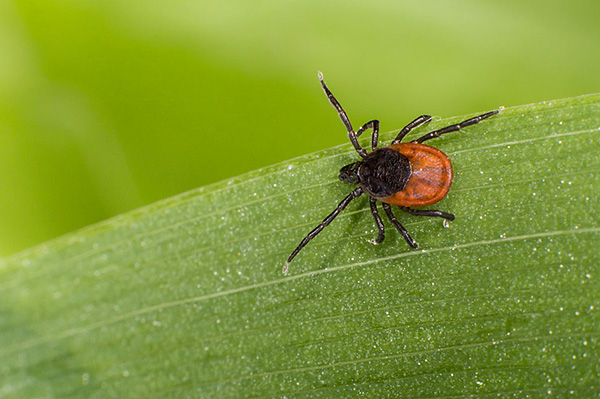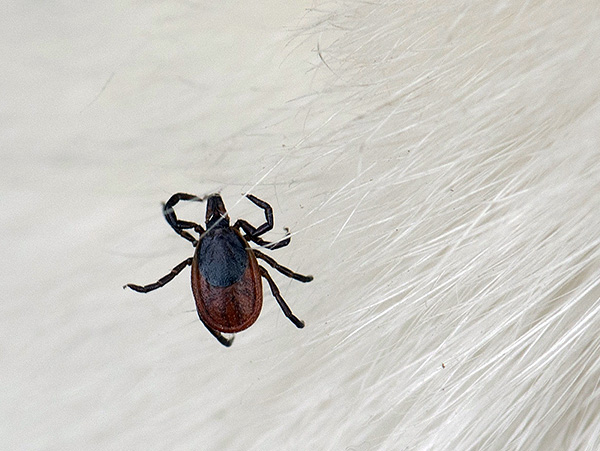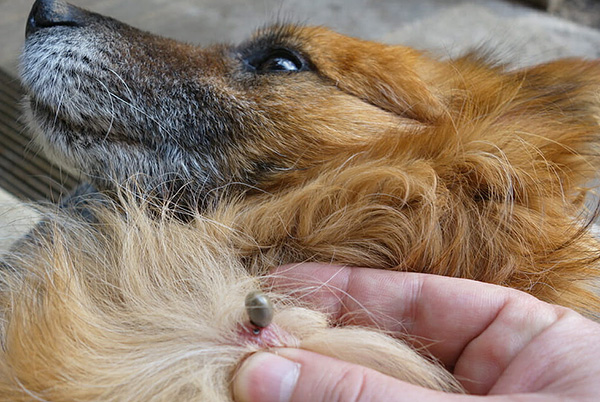
It is widely known that ticks can carry diseases that are dangerous to humans. But a person is often an accidental and not their main victim. Ixodid ticks are, first of all, parasites of wild animals, but if successful, they do not disdain either a person or his pets.
Moreover, it is dogs that are especially susceptible to tick-borne diseases, unlike, for example, cats - and not only because dogs are more mobile, love playing on the grass more and there are more long-haired breeds among them. The features of the immune system also make a significant contribution.
Let's see if dogs suffer from tick-borne encephalitis and how this disease and other tick-borne infections are generally dangerous for them ...
Can a dog develop tick-borne encephalitis?
Tick-borne encephalitis is a disease that can have severe consequences in humans. It is caused by a virus that multiplies in the cells of the central nervous system, often causing irreversible damage and leading to serious health consequences, disability, and sometimes death. It is noteworthy that dogs are not susceptible to this infection as much as humans.

At the same time, it cannot be considered that the probability of developing this disease in a dog is absolutely excluded - several cases of infection of dogs with tick-borne encephalitis have been described.There are also reliable reports of the death of dogs from this infection - and if it did happen that the dog fell ill, then the virus very quickly affected the brain, leading to paralysis and, as a result, death of the animal. But these cases are very rare.
On a note
Only 14 species can be encephalitic ixodid ticks. At the same time, Ixodes ricinus (dog tick), and in the taiga zone and in Asia - Ixodes persulcatus (taiga tick).
The photos below show what these tick-borne encephalitis vectors look like:
Ixodes ricinus
Ixodes persulcatus
In general, you don’t have to worry that a dog will get sick with tick-borne encephalitis after a tick bite, since the likelihood of this is extremely small.
The main reason for such a striking resistance of dogs to the TBE virus is the specificity of the immune system, which is quite different from the human one. It is generally accepted that dogs are simply physiologically immune to the tick-borne encephalitis virus, and rare cases of the disease are nothing more than an exception that is not the norm and only confirms the general rule.
However, ticks can infect dogs with other infections that are more common than tick-borne encephalitis in humans and more dangerous specifically for dogs due to the higher frequency of deaths. In addition, the word "encephalitis" itself refers to an inflammatory reaction in the brain, and such inflammation can develop in a dog when infected with tick-borne infections of a bacterial nature.
Simply put, dogs rarely become infected with tick-borne encephalitis from ticks, but much more often than people, they become infected with other infections from these parasites, and no less dangerous.
The most dangerous tick infections for dogs
Among tick-borne diseases that can be complicated by severe damage to the central nervous system in dogs, one of the most common and dangerous for them is piroplasmosis. Another name for this disease is babesiosis.
In the process of a bite, along with the saliva of a tick, infectious agents - protozoa - parasites of red blood cells - the so-called piroplasms, also enter the pet's body. They can also be found in other blood components, but less frequently.

In each affected erythrocyte, on average, 2 piroplasms usually settle, but their number can reach seven. And in some cases, there are giant single parasites that occupy the entire red cell as a whole. These microorganisms in their places of accumulation destroy the cellular structures of blood cells, and since erythrocytes are responsible for transporting oxygen from the lungs to all organs and tissues of the animal, if they are damaged, the dog begins to suffer from a lack of oxygen, it quickly develops anemia.
In addition, the foreign agents themselves provoke a cascade of serious immune reactions, causing inflammatory processes in the body. The first sign of acute piroplasmosis is a sharp jump in temperature to 41-42 degrees. In this case, the dog becomes lethargic, apathetic, depressed. The skin and mucous membranes turn pale due to anemia, sometimes turn yellow. On the second or third day of illness, the urine of the animal becomes very dark - the kidneys cannot cope with the load with a lack of oxygen, and blood elements and bile pigments enter the secretions.
If the animal is left untreated or treated too late, then damage to the nervous system appears.They begin with weakness of the hind limbs, then turn into paralysis and end with the death of the animal on the third or fifth day of illness. However, if you contact the veterinarian in a timely manner, then there is every chance to cure the dog completely and without serious consequences.

Extremely rare, but there were precedents when only a few hours passed from the appearance of the first ailments in an animal to its death. It is believed that this is due to the special susceptibility to the disease of some individuals. Such a rapid course of the disease is especially characteristic for puppies.
There are also reverse cases, when the dog experiences periodic mild symptoms of the disease, followed by a normal state. This does not mean that the animal has overcome the infection. The strength of immunity is enough to prevent the disease from developing in full force - if there are wave-like deterioration in well-being, this indicates a sluggish infection. With this form of the disease, there is a significant burden on the immune system, which in the future may manifest itself in the form of allergies and autoimmune reactions. Therefore, if something made you suspect a chronic form of piroplasmosis, a veterinarian consultation is necessary.
On a note
Piroplasmosis is common throughout Eurasia, and infection of a dog can occur both in the wild and on a personal plot and even within the city. The area of infection is expanding. Today, there are mass outbreaks of piroplasmosis in dogs, and in the foci, mortality can reach 22-24%.
Another common disease that is dangerous for humans is Lyme borreliosis.In dogs, in the vast majority of cases, a chronic form of this disease is observed, and the animal can be a carrier of the infection for months and years.
Infection with tick-borne borreliosis occurs through the bites of ixodid ticks. The causative agent is microorganisms of the genus Borrelia, which have an elongated spirally twisted shape. Borrelia parasitize in various organs and tissues, due to which the manifestations of borreliosis can be very diverse.

Borrelia burgdorferi - the causative agent of Lyme borreliosis
In the classic case, dogs are most often affected by the musculoskeletal system, namely the joints. Local symptoms begin to gradually spread from the bite site, where Borrelia breed, throughout the body, affecting ever larger areas. The dog may show lethargy, sleep more often, begins to limp when walking. This is a sure sign of arthritis and a signal that you need to urgently consult a veterinarian.
Sometimes borreliosis affects the heart muscle, causing tachycardia and other problems with the cardiovascular system in the dog. Kidney damage also occurs - Borrelia cause acute inflammation of the excretory organs - in particular, infectious nephritis.
Borreliosis can also cause encephalitis - penetrating into the nervous system, borreliae affect the meninges and nerve cells.
The difficulty for the specialist is to differentiate Lyme disease from diseases of a different nature. Often, deaths occur precisely because of an incorrect diagnosis. Nevertheless, dogs rarely die from borreliosis, but in the event of a serious damage to the nervous system, a lethal outcome is by no means excluded.
On a note
It is not uncommon for a dog to have many different symptoms that are characteristic of several diseases. Indeed, often when a tick bites, it transmits several infections to the dog at once. The likelihood of this is especially high if several long-feeding parasites were removed from the animal at once.
What else can a pet get?
In addition to piroplasmosis and Lyme borreliosis, ticks can also carry some other infections that are dangerous for dogs.
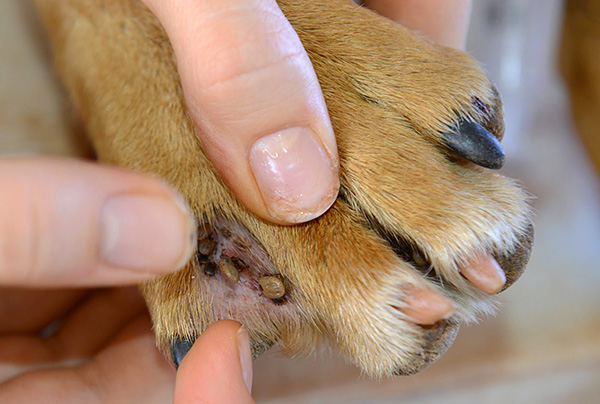
For example:
- Spotted fever is an acute infection, manifested by a complex of febrile symptoms. The disease is caused by rickettsia - tiny microorganisms, infection with which leads to a sharp increase in temperature, the appearance of reddish spots on the body, drowsiness, swelling, loss of coordination, pain in the muscles and eyes. Fever is often accompanied by conjunctivitis with hemorrhages. Blood also gets into the dog's secretions. The disease begins very quickly, and without proper treatment can lead to the death of the animal;
- Ehrlichiosis is a disease that also belongs to rickettsiosis. Ehrlichia parasitize in blood monocytes and migrate with them throughout the body. A favorite target of this disease is the lymph nodes, which begin to swell even in the initial stage of the disease. The temperature also rises, purulent discharge from the eyes is recorded. Sometimes erlichia can also penetrate the nervous system, which is fraught with encephalitis. However, this disease is usually not fatal, although it can bring a lot of trouble to the dog and its owner. A dog is often infected with ehrlichiosis together with piroplasmosis, because they are carried by the same types of ticks;
- Hepatozoonosis is the only disease on the list that is not transmitted by the bite of a parasite, but by accidentally eating a tick by a pet. In the intestines of the dog, unicellular parasites of the genus Hepatozoon are released, from where they are already spread throughout the body. In the blood, they are found in white bodies - leukocytes. There is nothing characteristic in the symptoms - general infectious signs are observed. It is possible to differentiate hepatozoonosis only with the help of modern diagnostic methods;
- Bartonellosis is a very common disease among pets, more common in cats. Bartonella is a bacteria that can be transmitted to a dog not only through ticks, but also through fleas, flies, and lice. When they enter the bloodstream, these microorganisms invade the erythrocytes, causing them to stick together (agglutination). Thus, in sick dogs, bleeding, heart problems, anemia, and weight loss are recorded. Symptoms vary from case to case and are very individual.
What to do if a dog is bitten by a tick: first aid measures
If a tick was found on a pet, then the first step is to remove the parasite from the animal's skin. It is necessary to perform this manipulation as quickly as possible (without delaying for several hours), but at the same time do not fuss and do not panic. Remember: if a tick has bitten, this does not mean that the dog will get sick with something.

It is worth mentioning here that it is not necessary to sharply pull out a sucked tick - its body can come off the head, which will remain in the wound and cause suppuration. Applying oil or other liquids to a bitten tick is ineffective - it can kill the parasite, but it will not make it crawl out of the wound on its own.
It is best to remove the tick with twisting movements, gently picking up special device for removing ticks, or, in extreme cases, tweezers, or even nails.
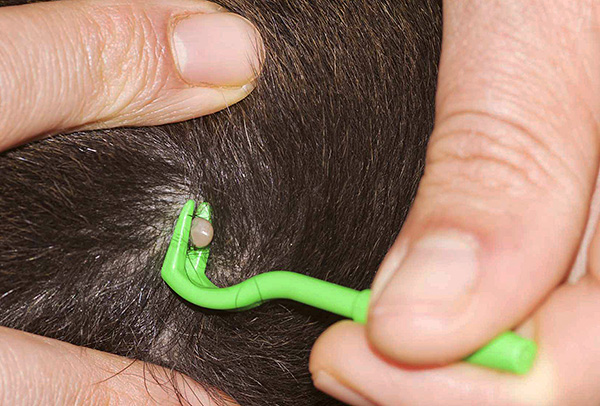
When removing the parasite, it is advisable to use gloves, especially if the skin has scratches or any other damage - the tick should not be allowed to come into contact with broken skin. The wound in the dog should definitely be treated with an antiseptic, and after the procedure for extracting the parasite, wash your hands with soap and water.
See also article
If we talk about the danger of infection, then several factors are important here: how many ticks bit the dog, how long they were attached, and in what region it happened.
Infectious agents enter the bloodstream through infected saliva, and therefore the more individuals have attached themselves to the animal and the longer they have fed on it, the higher the potential likelihood that the dog will get sick.

Another aspect is the region where the fact of the bite took place. If a given area is unfavorable for tick infections, then the percentage of infected ticks in it is relatively high.
Strictly speaking, it is possible to find out immediately after the extraction of the parasite whether it is a carrier of the infection. For this, the tick is examined in the laboratory, where in a few hours they can issue a conclusion on its status. However, such an analysis for infections that dogs are susceptible to is not carried out in every laboratory (or rather, most of them are not).
However, even the detection of dangerous pathogens in a tick does not mean that the corresponding disease will develop. The immunity of many dogs allows them to avoid any symptoms even when infected - in many of them the pathogen in the body quickly dies.
On a note
There is a practice for people emergency prevention of tick-borne encephalitis, which can be produced in the first hours, or a day after the bite. After receiving an injection, a person will not get sick even if an infected tick attacks. However, in the case of infections dangerous to dogs, such preventive measures are not carried out.
Thus, if a dog is bitten by one tick, then you do not need to immediately run to the doctor or carry the parasite for analysis. However, in the following days, it is important to carefully monitor the condition of the pet, and if signs of infection appear, then immediately contact the veterinarian.
What are the early signs of a disease?
Immediately after a tick bite, no changes in the pet's well-being usually occur. Even if the infection is transmitted, it needs time to manifest itself in full force. The incubation period for tick-borne infections in dogs varies on average from one to three weeks, but sometimes it is reduced to 4-5 days (in rare cases it can be extended to several months, which is typical for borreliosis, which can go unnoticed for a very long time and then suddenly manifest itself in acute form).
Tick-borne diseases in dogs, as a rule, begin abruptly - any attentive owner immediately notices how the pet's behavior changes. The dog becomes lethargic, sleeps more, refuses to play and eat. There may be shortness of breath, a change in gait, darkening of the urine. The most important first symptom is a jump in body temperature (see also Symptoms that can appear in a dog after a tick bite).

In this case (especially if a recent tick bite is known), the best first aid is to keep the animal as calm as possible and see a veterinarian as soon as possible.Tick infections are very insidious - sometimes they can go away on their own as quickly as they started. But in other cases, complex multi-stage treatment is required, without which the dog will quickly die.
On a note
Thoroughbred animals are usually more difficult to tolerate piroplasmosis and recover longer than their simple street relatives. There is also a higher chance of getting sick in small dogs than in large ones.
In general, if everything is fine with the dog after three weeks after the tick bite, then we can assume that the risk of developing the disease is already very low. This means that either the tick was not contagious, or the infection did not enter the dog's body, or even after infection, the disease did not develop, since the pathogen was eliminated by the immune system.

Important!
At the first suspicious symptoms, it is better to take the animal to the veterinarian as soon as possible - some diseases can develop to an irreversible stage in just a couple of days, and the doctor may simply not have time to save the dog.
Treatment of the pet, if the infection did occur
Tick infections are too serious to attempt at home. Since the symptoms of different diseases are similar in many ways, only a veterinarian can make the correct diagnosis (including by analyzing the blood of the animal).
The dog usually remains under supervision in a hospital veterinary clinic. The specialist will prescribe effective drugs in the right dosage, and this is a very important stage - those drugs that give results in piroplasmosis may not help with Lyme disease at all, which is why correct diagnosis is so important.For a non-specialist, virtually any tick-borne disease cannot be visually diagnosed.
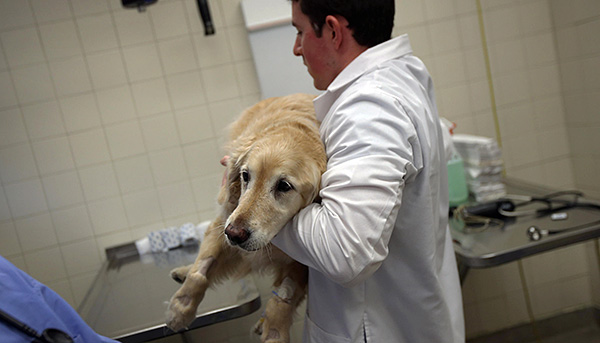
The treatment strategy is determined depending on the identified pathogen. When borrelia is affected, it will be an antibiotic that kills pathogens, plus a complex of drugs that alleviate the general condition of the dog. If, for example, Bartonella is detected (there are no antibiotics against them), then the treatment becomes symptomatic.
The disease depletes the pet, so for a speedy recovery, he needs a full, but sparing diet. For this, special nutritional supplements are being developed, saturated with useful substances and suitable specifically for recovering animals.
Can a person get tick-borne encephalitis or another infection from a dog?
Tick infections are not transmitted from dogs to humans (nor are they transmitted to pets). An exception may be infection of puppies in the womb of a sick mother, but in this case they almost always die before birth.

It is interesting
It is known for certain that sick cats, when scratching, can transmit bartonellosis to humans. But in relation to dogs, not a single such case was registered.
Thus, you can only get infected from an infected tick, so you should not be afraid to get an infection from your pet. Moreover, to some diseases that are dangerous for dogs, a person is generally weakly susceptible - first of all, this concerns piroplasmosis.
On a note
Despite the fact that it is impossible to catch the disease from your pet, it is quite possible to get it from a tick that was carelessly removed from a dog. There are known cases of borreliosis, when, when the parasite was accidentally crushed, people infected themselves by simply rubbing their eyes after that.Therefore, it is always better to remove the tick with gloves, and immediately after removing it, wash your hands with soap and water.
Infection prevention
Vaccination has been the most reliable method of preventing infections for humans for many years, but is not widely used for pets. The reason is that the dog's immunity is not able to store antibodies that protect against tick-borne diseases for a long time. In most cases, the vaccine is effective for no more than one or two months, and doing it every few weeks simply does not make sense.

Due to the limited availability of vaccinations in dogs, it is important to protect your pet through preventive measures and prevent tick bites. This is done with the help of such means as various anti-tick collars, drops on the withers and sprays. All of them contain chemicals that have a deterrent and destroying effect on parasites (including fleas).
Such remedies help reduce the likelihood of tick bites, but cannot guarantee one hundred percent protection. Therefore, it is important to inspect your pet after walking in parks and forest areas. Then, perhaps, it will be possible to catch the tick even before it has time to stick (ticks take a long time to choose the place most suitable for a bite). On dogs, the areas behind the ears, the auricles themselves, the groin, the armpits, and the spaces between the fingers are especially at risk of being bitten. It is in these places that ticks are most often found.
Symptoms of piroplasmosis in dogs

